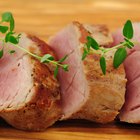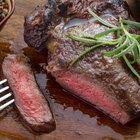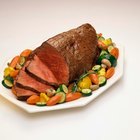loooby/iStock/GettyImages
Sirloin tip ranks as the most tender cut from the round and doesn't need braising for tenderness, but it can still benefit from a few hours of low-temperature cooking and reverse-searing, or searing after the roast finishes cooking. Choice sirloin tip has a lot of marbling that melts and coats the interior of the meat with unctuous rendered fat and juices as it cooks; low-temperature cooking, to medium-rare to medium, makes the most of it.
You don't have to go beyond salt and pepper when it comes to seasoning, either. Sirloin tip roast has one of the beefiest flavors of all beef cuts – choice gets its flavor from both connective tissue and marbling, the most marbling you'll find next to prime-grade beef. You want to buttress that flavor with as much tenderness as you can, and early salting can help.
Early Seasoning
Early and heavy seasoning, as in 12 to 24 hours before you want to cook the tip roast, increases tenderness by "loosening" or "unraveling" the coiled muscle fibers that make up beef and helps the salt move deep into the meat.
Save the marinades for cheaper, less beefy cuts like flank or skirt steak. Acidic marinades don't tenderize as well as early salting does, and they alter the pure flavor of a choice sirloin tip roast.
Cooking the Roast
Season the tip roast. Use salt and pepper for the truest beef flavor. If you salted early as well, wipe off the excess salt using a moist paper towel and pat the meat dry.
Heat the oven to the lowest setting. You can set the oven between 200F and 275F, depending on how low your oven goes.
Slow-cook the tip roast for 40 minutes per pound. Cooking time ultimately depends on oven temperature, but you can use 40 minutes per pound as a guide. The internal temperature should measure around 125F for medium rare and 130F for medium.
Sear the tip roast. Heat 1 tablespoon of vegetable oil and 1 tablespoon of butter in a heavy-bottomed skillet over medium (gas stove) or medium-high (electric stove) heat until it starts smoking. Sear the roast on all sides until it turns a rich golden brown color, about 1 minute total.
Related Articles
The Best Way to Cook Moist Tri Tip
The Best Way to Cook Four Pounds of ...

How to Cook a 15-Pound Rib Roast

How to Make a Blackbuck Antelope Roast

How to Convection Roast a Brisket

How to Cook Beef Tenderloin With the ...

How to Make an Eye of Round Less Tough ...

How to Roast a Pork Blade Cut

How to Cook Veal Sirloin

How to Cook a Seamed Eye Round

How to Marinate a Top Round Roast
Cooking a Brisket in the Oven

How to Cook a Tri Tip on a Propane Grill

Does Simmering Ground Beef Make It More ...

Tri Tip Cooking Methods

How to Grill a Ribeye on a Weber Q

How to Cook Venison Shoulder Roast in a ...

Calories in Beef Rump Roast

How to Smoke Elk Meat

Meals Made With Leftover Roast Beef
References
Resources
Tips
- If you want to grill your roast, place it in a 500-degree grill and close the lid. Cook at high heat for the first 15 minutes and then reduce the heat to 325 degrees for the remainder of the cooking time.
- There is no need to add liquid to the roasting pan. The meat’s fat will provide the moisture needed to keep it juicy and tender.
Warnings
- Always sanitize your workspace and wash your hands after handling raw beef. Improper handling may cause the spread of illness-causing germs.
- The safe internal temperature for beef is 140 degrees Fahrenheit. Consuming meat that has been cooked to cooler temperatures may put you at risk for foodborne illnesses.
- Beware when using your oven or grill at extremely high temperatures. The heat will radiate to the outside of the appliance and may cause a burn risk to people and pets.
Writer Bio
A.J. Andrews' work has appeared in Food and Wine, Fricote and "BBC Good Food." He lives in Europe where he bakes with wild yeast, milks goats for cheese and prepares for the Court of Master Sommeliers level II exam. Andrews received formal training at Le Cordon Bleu.